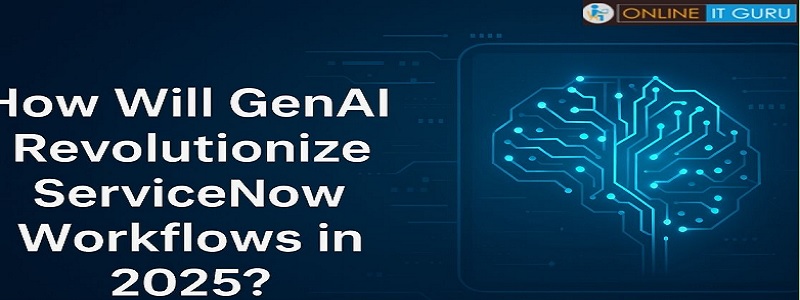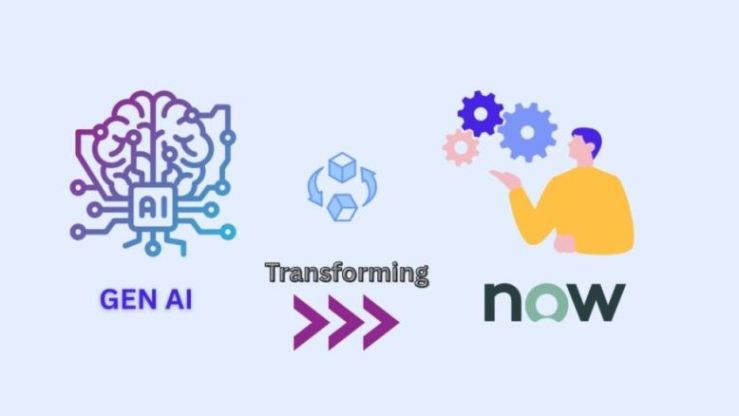
Today, GenAI is transforming ServiceNow Workflows in 2025 by bringing many changes. It is changing with advanced automation, predictive analytics, and streamlined user interactions to key business functions. ServiceNow AI enables businesses to boost efficiency in IT, HR, and customer support. Hence, it leverages automated processes, anticipating issues, and enhancing user accessibility. Let’s explore how these workflows bring new changes with Gen AI.
What are the ServiceNow workflows?
ServiceNow Workflows are now remarkably efficient and adaptive with GenAI at their core. Automation stands out as the main advantage. Its intelligent agents tirelessly handle repetitive ITSM, HRSD, and CSM tasks, freeing teams for high-impact projects.
The Now Assist GenAI function in IT service management. For instance, it helps agents reduce resolution times from 30 minutes to less than 10 minutes by summarizing issues. It does so by retrieving related documents and creating resolution steps. Further, it performs predictive task routing, self-service portals with AI-powered suggestions, and automated document intelligence. It gathers and categorizes data from many departments are more examples of ServiceNow workflows.
The Evolution of GenAI and ServiceNow AI
As the industry leader in process automation solutions, Service Now has developed into a potent AI-driven platform. But the core of this change is generative AI, or GenAI for short. Further, LLMs and natural language interaction are features of ServiceNow AI. It allows users to activate workflow in ServiceNow by just "talking" to the system. Moreover, this innovative change redefines task automation, incident resolution, and company decision-making.

How Does GenAI Transform the ServiceNow Workflow?
ServiceNow Workflows can accomplish several important goals with GenAI. These are as follows:
- It is 40–60% quicker in delivering incident and service request resolution rates.
- It uses virtual agents and clever self-service portals, and reduces the number of tickets by 30%.
- Also, it reduces human involvement and more precise automation that resulting in 20–50% cheaper operating expenses.
- Further, improved decision-making by detecting workflow issues and suggesting fixes through AI-driven analytics and process mining.
Enhance your skills in process automation to upgrade your career by joining the online ServiceNow Training from OnlineITGuru.
ServiceNow Workflow Examples in 2025
The following prominent scenarios highlight the influence of GenAI in ServiceNow workflows:
1) IT Service Desk Automation:
GenAI reduces manual labor and mistake rates by identifying, classifying, and resolving tickets. For this, it uses historical data and predicted insights.
2) HR Onboarding:
ServiceNow AI manages document sharing and assigns assignments to new hires. Also, it automatically responds to inquiries from new hires. Therefore, it provides a smooth onboarding process.
3) Customer service:
By using ServiceNow AI to power virtual agents, customer satisfaction levels are raised by suggesting pertinent articles and next steps in response to user inquiries.
4) Finance and Compliance:
In this case, vital data for auditing, approvals, and compliance reporting is extracted and validated by automated document intelligence.
Low-Code and No-Code Revolution for Workflows
Business users can develop, customize, and launch workflows with ease using ServiceNow's low-code Flow Designer. It has been improved with GenAI. Moreover, complex processes may now be mapped and automated without technical knowledge. The workflow builder's integration of natural language queries and AI-powered suggestions is the core.
Every team, from field services to IT, can swiftly optimize procedures for accuracy and speed because of globalization. Further, workflows may virtually immediately eliminate bottlenecks, automate approvals, interact with other AI models, and connect systems.
Related Article: ServiceNow Automation
Scaling Automation Throughout the Departments
By 2025, ServiceNow Workflows will benefit from GenAI-powered hyperautomation. This entails automating dynamic, cross-departmental operations in addition to conventional duties. Examples include utilizing AI-driven decision tables for real-time approvals, connecting Service Now with Microsoft Teams or Copilot, etc. Further, there are examples, like syncing HR, IT, and finance workflows for smooth teamwork.
Mobile-First User Experiences:
Employees use mobile devices to manage workflows, approvals, and even HR onboarding for maximum flexibility.
Hyperautomation:
IT, HR, finance, and other departments are connected through integrated workflows that support enterprise-wide change.
AI-Driven Suggestions:
It helps with autonomous suggestions for predictive escalation, real-time analytics, and process enhancement.
Are you looking to become an expert in ServiceNow Workflows? Opt for the updated ServiceNow Online Training today and grab new opportunities.
Components of ServiceNow Workflows
The following are the key components of the ServiceNow Workflows:
1) Workflow Editor
A workflow editor is a visual interface or drag-and-drop tool used by many designers to link and arrange the steps in a business process.
2) Activities
These represent the discrete components or work units that comprise the workflow. Here, a certain task is carried out by each activity. Among the examples are notifications, approvals, tasks, scripts, etc.
3) Transitions
The lines or connectors that specify the order and progression of actions are these. Based on the results or events of the previous activity, they choose the next course of action for the process.
4) Workflow Engine
The workflow logic is dealt with and carried out by this underlying system, which also controls task progress and automates tasks according to the given path.
What AI model does ServiceNow use?
A key element of ServiceNow's platform is its AI models, which include the recently launched v2.0 versions of its LLM and Small Language Model (SLM). These models, which are intended to manage complex corporate scenarios, enhance performance and speed for jobs across the platform and fuel gen AI experiences through products like Now Assist. Important uses include agentic workflows, which enable AI agents to act on their own, and data analysis for trends, forecasting, and action suggestions.
Advance your low-code process automation skills with the ServiceNow Course online.
Benefits of ServiceNow Workflows
ServiceNow Workflows help to create value. It helps to simplify and automate both simple and intricate business procedures. Among the main benefits are
1) Improved Business Outcomes:
By automating the routing of requests, decisions, approvals, and escalations, Service Now enables companies to address problems more quickly and consistently.
2) Simplified Communication:
It simplifies communications by handling all requests and approvals centrally. It helps by doing away with laborious email chains and human follow-ups.
3) Information Transparency and Accountability:
A workflow's reliability and openness are increased by tracking each stage and clearly identifying who is responsible for what.
4) Optimal Quality of Service and Compliance:
Workflows that are automated to ensure real-time updates, help avoid expensive mistakes, and facilitate monitoring and auditing. They are all essential for regulatory compliance.
5) Efficient Work Across Departments:
By removing redundant procedures, Service Now facilitates seamless collaboration between departments and enhances the experience of both customers and employees.
6) AI-Driven Process Optimization:
GenAI and ServiceNow AI reduce human intervention and enable proactive operations by integrating self-service capabilities and AI into processes.
7) Enterprise-Grade Security:
Strong cybersecurity automation, data encryption, and role-based limits on access improve every workflow.
8) Cost Reduction and Scalability:
Automation speeds up development processes, lowers labor costs, and enables business users. This helps to generate solutions without knowing how to code.
Best Practices for ServiceNow AI Workflows
Keep up with the most recent developments in the industry to get the most out of ServiceNow Workflows powered by GenAI:
- To find repetitive operations that are ready for automation, use Automation Discovery.
- Reduce response times and ticket volumes by implementing Now Assist for ITSM and CSM.
- It helps to provide low-code/no-code tools to citizen developers so they may personalize workflows.
- Utilize AI dashboards and integrated analytics to track workflow performance.
- Moreover, to obtain specialized workflow intelligence, incorporate external AI models.
- Emphasis on ongoing improvement and data-driven insights.
Get hands-on skills and expert mentorship from industry experts in process automation and ServiceNow workflows with the ServiceNow Developer Course.
Conclusion
By automating manual operations, increasing accuracy, and improving business outcomes across all industries, GenAI will transform ServiceNow Workflows in 2025. With the power and flexibility that ServiceNow AI offers, businesses can improve productivity and establish more intelligent processes. Further, it helps to attain operational excellence. GenAI is actually improving ServiceNow workflow in a variety of areas, including IT service management, HR, finance, customer support, and more. So, be a part of this amazing change in the industry by opting for upskilling in this technology.